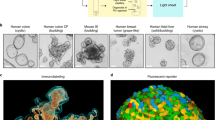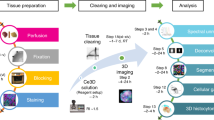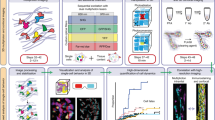Abstract
We describe a three-dimensional (3D) confocal imaging technique to characterize and enumerate rare, newly emerging hematopoietic cells located within the vasculature of whole-mount preparations of mouse embryos. However, the methodology is broadly applicable for examining the development and 3D architecture of other tissues. Previously, direct whole-mount imaging has been limited to external tissue layers owing to poor laser penetration of dense, opaque tissue. Our whole-embryo imaging method enables detailed quantitative and qualitative analysis of cells within the dorsal aorta of embryonic day (E) 10.5–11.5 embryos after the removal of only the head and body walls. In this protocol we describe the whole-mount fixation and multimarker staining procedure, the tissue transparency treatment, microscopy and the analysis of resulting images. A typical two-color staining experiment can be performed and analyzed in ∼6 d.
This is a preview of subscription content, access via your institution
Access options
Subscribe to this journal
Receive 12 print issues and online access
$259.00 per year
only $21.58 per issue
Buy this article
- Purchase on Springer Link
- Instant access to full article PDF
Prices may be subject to local taxes which are calculated during checkout








Similar content being viewed by others
References
Dzierzak, E. & Speck, N.A. Of lineage and legacy: the development of mammalian hematopoietic stem cells. Nat. Immunol. 9, 129–136 (2008).
Medvinsky, A., Rybtsov, S. & Taoudi, S. Embryonic origin of the adult hematopoietic system: advances and questions. Development 138, 1017–1031 (2011).
Marshall, C.J. & Thrasher, A.J. The embryonic origins of human haematopoiesis. Br. J. Haematol. 112, 838–850 (2001).
Tavian, M. et al. Aorta-associated CD34+ hematopoietic cells in the early human embryo. Blood 87, 67–72 (1996).
Gard, D.L. Confocal immunofluorescence microscopy of microtubules in amphibian oocytes and eggs. Methods Cell Biol. 38, 241–264 (1993).
Zucker, R.M., Hunter, E.S. & Rogers, J.M. (eds.) Confocal Laser Scanning Microscopy of Morphology and Apoptosis in Organogenesis-Stage Mouse Embryos 191–202 (Humana Press, 1999).
Yokomizo, T. & Dzierzak, E. Three-dimensional cartography of hematopoietic clusters in the vasculature of whole mouse embryos. Development 137, 3651–3661 (2010).
Ng, C.E. et al. A Runx1 intronic enhancer marks hemogenic endothelial cells and hematopoietic stem cells. Stem Cells 28, 1869–1881 (2010).
Yokomizo, T., Ng, C.E., Osato, M. & Dzierzak, E. Three-dimensional imaging of whole midgestation murine embryos show an intravascular localization for all hematopoietic clusters. Blood 117, 6132–6134 (2011).
Garcia-Porrero, J.A., Godin, I.E. & Dieterlen-Lievre, F. Potential intraembryonic hemogenic sites at pre-liver stages in the mouse. Anat. Embryol. (Berl.) 192, 425–435 (1995).
Garcia-Porrero, J.A. et al. Antigenic profiles of endothelial and hemopoietic lineages in murine intraembryonic hemogenic sites. Dev. Comp. Immunol. 22, 303–319 (1998).
Ghiaur, G. et al. Rac1 is essential for intraembryonic hematopoiesis and for the initial seeding of fetal liver with definitive hematopoietic progenitor cells. Blood 111, 3313–3321 (2008).
Jaffredo, T. et al. Aortic remodelling during hemogenesis: is the chicken paradigm unique? Int. J. Dev. Biol. 54, 1045–1054 (2010).
Zovein, A.C. et al. Vascular remodeling of the vitelline artery initiates extravascular emergence of hematopoietic clusters. Blood 116, 3435–3444 (2010).
Ferkowicz, M.J. & Yoder, M.C. (eds). Whole Embryo Imaging of Hematopoietic Cell Emergence and Migration 143–155 (Springer Science-Business Media, 2008).
Yokomizo, T. et al. Requirement of Runx1/AML1/PEBP2αB for the generation of haematopoietic cells from endothelial cells. Genes Cells 6, 13–23 (2001).
Yoshida, H. et al. Hematopoietic tissues, as a playground of receptor tyrosine kinases of the PDGF-receptor family. Dev. Comp. Immunol. 22, 321–332 (1998).
Hogan, B., Beddington, R., Constantini, F. & Lacy, E. Manipulating the Mouse Embryo: A Laboratory Manual 2nd ed. (Cold Spring Harbor Laboratory Press, 1994).
Becker, K., Jahrling, N., Kramer, E.R., Schnorrer, F. & Dodt, H.U. Ultramicroscopy: 3D reconstruction of large microscopical specimens. J. Biophotonics 1, 36–42 (2008).
Acknowledgements
We thank the members of the laboratory for critical comments related to this work and also thank the following funding organizations: the US National Institutes of Health grants R37DK054077 (E.D.) and RO1HL091724 (N.A.S.), the Netherlands BSIK Innovation Program 03040 (E.D.) and the European Science Foundation Program EuroSTELLS 01-011 (E.D.), and the Netherlands Genomics Initiative—Cancer Genomic Distinguished Scientist Award (N.A.S.).
Author information
Authors and Affiliations
Corresponding author
Ethics declarations
Competing interests
The authors declare no competing financial interests.
Supplementary information
Supplementary Video 1
3D reconstructed video of a whole E9 embryo (14 sp). Ly6A-GFP transgenic embryo was stained with anti-GFP antibody (green) and anti-CD31 antibody (magenta). Picture was taken by x10 objective (HC PL APO CS x10/NA 0.4). Video was generated by Bitplane Imaris (Bitplane AG, Zurich Switzerland) assembling 311 slices (optical sections with 1.3 µm per z-step). (MOV 6085 kb)
Rights and permissions
About this article
Cite this article
Yokomizo, T., Yamada-Inagawa, T., Yzaguirre, A. et al. Whole-mount three-dimensional imaging of internally localized immunostained cells within mouse embryos. Nat Protoc 7, 421–431 (2012). https://doi.org/10.1038/nprot.2011.441
Published:
Issue Date:
DOI: https://doi.org/10.1038/nprot.2011.441
This article is cited by
-
Independent origins of fetal liver haematopoietic stem and progenitor cells
Nature (2022)
-
Lifelong multilineage contribution by embryonic-born blood progenitors
Nature (2022)
-
Dynamics of myogenic differentiation using a novel Myogenin knock-in reporter mouse
Skeletal Muscle (2021)
-
Unique N-terminal sequences in two Runx1 isoforms are dispensable for Runx1 function
BMC Developmental Biology (2017)
-
Cycles of vascular plexus formation within the nephrogenic zone of the developing mouse kidney
Scientific Reports (2017)
Comments
By submitting a comment you agree to abide by our Terms and Community Guidelines. If you find something abusive or that does not comply with our terms or guidelines please flag it as inappropriate.



